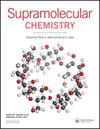Model binding experiments with cucurbit[7]uril and p-sulfonatocalix[4]arene support use of explicit solvation term in governing equation for binding equilibria
IF 2.6
4区 化学
Q3 CHEMISTRY, MULTIDISCIPLINARY
引用次数: 1
Abstract
ABSTRACT The thermodynamics of model host–guest-binding reactions is examined in depth using isothermal titration calorimetry. In conflict with classical thermodynamics, the results indicate that the equilibrium-binding quotient, K, is not a constant for all pairings. This outcome is predicted by an equation for binding equilibria that includes an explicit term for the change in solvation free energy that accompanies the formation of a binary complex. Application of this framework to the experimentally observed concentration dependence of K allows one to obtain the energetic contribution of the solvent, a linked equilibrium denoted here as ΔG H2O. The estimated values of ΔG H2O are large and unfavourable for the binding of selected guest molecules to two hosts, cucurbit[7]uril and p-sulfonatocalix[4]arene. Intriguingly, the estimated values of ΔG H2O are near zero for the binding of two hydrophobic guest molecules to β-cyclodextrin, leading to a thought-provoking discussion on the driving force behind the hydrophobic effect. Graphical abstract葫芦丝[7]脲和对磺酰基[4]芳烃的模型结合实验支持在结合平衡控制方程中使用显式溶剂化项
采用等温滴定量热法对模型主-客体结合反应的热力学进行了深入研究。与经典热力学相矛盾的是,结果表明平衡结合商K不是所有配对的常数。这一结果是由一个结合平衡方程预测的,其中包括伴随二元配合物形成的溶剂化自由能变化的显式项。将这一框架应用于实验观察到的K的浓度依赖性,可以得到溶剂的能量贡献,这里表示为ΔG H2O的链接平衡。ΔG H2O的估定值较大,不利于选定的客体分子与两种寄主(葫芦[7]脲和对磺酰基[4]芳烃)结合。有趣的是,对于两个疏水来宾分子与β-环糊精的结合,ΔG H2O的估价值接近于零,这引发了关于疏水效应背后驱动力的发人深省的讨论。图形抽象
本文章由计算机程序翻译,如有差异,请以英文原文为准。
求助全文
约1分钟内获得全文
求助全文
来源期刊

Supramolecular Chemistry
化学-化学综合
CiteScore
3.60
自引率
3.00%
发文量
5
审稿时长
2.7 months
期刊介绍:
Supramolecular Chemistry welcomes manuscripts from the fields and sub-disciplines related to supramolecular chemistry and non-covalent interactions. From host-guest chemistry, self-assembly and systems chemistry, through materials chemistry and biochemical systems, we interpret supramolecular chemistry in the broadest possible sense. Interdisciplinary manuscripts are particularly encouraged. Manuscript types include: high priority communications; full papers; reviews, and; Methods papers, techniques tutorials highlighting procedures and technologies that are important to the field. We aim to publish papers in a timely fashion and as soon as a paper has been accepted and typeset it will be published in electronic form on the Latest articles section of the website. The two most important review criteria are that the paper presents high-quality work that fits generally into the broad spectrum of activities in the supramolecular chemistry field. Under normal circumstances, Supramolecular Chemistry does not consider manuscripts that would be more suitable in a highly specialized journal. This includes, but is not limited to, those based mostly or exclusively on topics such as solid state/X-ray structures, computational chemistry, or electrochemistry. .
The two most important review criteria are that the paper presents high-quality work that fits generally into the broad spectrum of activities in the supramolecular chemistry field.
 求助内容:
求助内容: 应助结果提醒方式:
应助结果提醒方式:


